- Home
- Orhan Pamuk
My Name is Red Page 43
My Name is Red Read online
Page 43
It was with such melancholy and regret that I entered this world of fine and delicate feelings, the possibility of whose depiction my soul had quietly forgotten over years of rendering wars and celebrations for Our Sultan. In an album of collected pictures I saw a red-lipped, thin-waisted Persian boy holding a book on his lap exactly as I was holding one at that moment, and it reminded me of what shahs with a weakness for gold and power always forget: The world’s beauty belongs to Allah. On the page of another album drawn by a young master from Isfahan, with tears in my eyes, I beheld two marvelous youths in love with each other, and was reminded of the love my own handsome apprentices nourished for painting. A tiny-footed, transparent-skinned, weak and girlish youth had bared a delicate forearm, which aroused in one the desire to kiss it and die, while a cherry-lipped, almond-eyed, sapling-thin, button-nosed beauty of a maiden gazed with wonder — as though viewing three lovely flowers — upon the three small, deep marks of passion the youth had burned onto the inside of that adorable arm to demonstrate the strength of his love and his attachment to her.
Oddly, my heart began to quicken and pound. As had happened sixty years ago in my early apprenticeship, while I was looking at some rather indecent illustrations of handsome marble-skinned boys and slim small-breasted maidens drawn in the black-ink style of Tabriz, beads of sweat accumulated on my forehead. I recalled the passion for painting I felt and the depth of thought I experienced when, a few years after I’d married and taken my first steps toward master status, I saw a lovely angel-faced, almond-eyed, rose-petal-skinned youth brought in as an apprentice candidate. For a moment, I had the strong feeling that painting was not about melancholy and regret but about this desire I felt and that it was the talent of the master artist that first transformed this desire into a love of God and then into a love of the world as God saw it; so strong was this feeling that it caused me to relive with ecstatic delight all the years I’d spent over the drawing board until my back was hunched, all the beatings I’d endured while learning my craft, my dedication to courting blindness through illustration and all the agonies of painting I’d suffered and made others suffer. As if running my eyes over something forbidden, I stared long and silently at this wondrous illustration with the same delight. Much later I was still staring. A teardrop slid from my eye over my cheek into my beard.
When I noticed that one of the candlesticks slowly floating through the Treasury was approaching me, I put the album away and randomly opened one of the volumes the dwarf had recently set beside me. This was a special album prepared for shahs: I saw two deer at the edge of a green copse enamored of each other, with jackals watching them in hostile envy. I turned the page: Chestnut and bay horses that could’ve been the work of only one of the old masters of Herat — how spectacular they were! I turned the page: A confidently seated governmental official greeted me from a seventy-year-old picture; I couldn’t determine who it was from the face because he looked like anybody, or so I thought, yet the air of the painting, the seated man’s beard painted in various hues recalled something. My heart beat quickly as I recognized the execution of the magnificent hand in the piece. My heart knew before I did, only he could’ve drawn such a splendid hand: This was the work of Bihzad. It was as if light were gushing from the painting to my face.
I had seen pictures drawn by the Great Master Bihzad a few times before; perhaps because I hadn’t looked at them alone, but in a group of former masters years ago, perhaps because we couldn’t be certain whether it was indeed the work of the great Bihzad, I hadn’t been as taken as I was now.
The heavy moldy darkness of the Treasury chamber seemed to brighten. This beautifully drawn hand merged in my mind with that thin, magnificent arm branded with signs of love, which I’d just now seen. Again, I praised God for showing me such spectacular beauty before I went blind. How do I know I’ll soon be blind? I don’t know! I sensed that I could share this intuition of mine with Black, who’d sidled up to me holding a candle and was looking at the page, but something else came out of my mouth.
“Behold the remarkable rendering of the hand,” I said. “It’s Bihzad.”
My hand went of its own will to hold Black’s, as if it were holding the hand of one of those soft, velvet-skinned, beautiful apprentice boys, each of whom I’d loved in my youth. His hand was smooth and firm, warmer than my own, delicate and broad, and I was thrilled by the veined side of his wrist. When I was young, I would take an apprentice child’s hand into my palm and, before telling him how to hold the brush, I’d gaze with affection into his sweet, frightened eyes. That’s how I looked at Black. Reflected in his pupils, I saw the flame of the candle he held aloft. “We miniaturists are brethren,” I said, “but now everything is coming to an end.”
“How do you mean?”
I said, “Everything is coming to an end” like a great master who longs for blindness, having devoted his years to a lord or a prince, having created masterpieces in his workshop in the style of the ancients, having even ensured that this workshop had its own style, a great master who knows, whenever his patron lord loses his last battle, that new lords will come in the wake of the plundering enemy, disband the workshop, tear apart bound volumes leaving the pages in disarray and belittle and destroy what remains, including the fine details that he long believed in, that were of his own discovery and that he loved like his own children. But I needed to explain this to Black differently.
“This illustration is of the great Poet Abdullah Hatifi,” I said. “Hatifi was such a great poet that he simply stayed home while everybody else rushed out and toadied up to Shah Ismail after the king took Herat. In response, Shah Ismail personally went all the way to his house on the outskirts of the city to see him. We know this is Hatifi, not from Bihzad’s rendering of Hatifi’s face, but from the writing beneath the illustration, don’t we?”
Black looked at me, indicating “yes” with his pretty eyes. “When we look at the face of the poet in the painting,” I said, “we see that it could be a face like any other face. If Abdullah Hatifi were here, God rest his soul, we could never hope to recognize him from the face in this picture. However, we could do so relying on the illustration in its entirety: There’s something in the manner of the composition, in Hatifi’s pose, in the colors, the gilding and the stunning hand rendered by Master Bihzad that at once indicates the picture is of a poet. Meaning precedes form in the world of our art. As we begin to paint in imitation of the Frankish and Venetian masters, as in the book that Our Sultan had commissioned from your Enishte, the domain of meaning ends and the domain of form begins. However, with the Venetian methods…”
“My Enishte, may he rest in eternal peace, was murdered,” Black said rudely.
I caressed Black’s hand, which rested within my own, as if respectfully stroking the tiny hand of a young apprentice who might one day indeed illustrate masterpieces. Quietly and reverently we looked at Bihzad’s masterpiece for a time. Later, Black withdrew his hand from mine.
“We passed quickly over the chestnut horses on the previous page without examining their noses,” he said.
“There’s nothing to them,” I said, and turned back to the previous page so he might see for himself: There was nothing extraordinary about the nostrils of the horses.
“When shall we find the horses with peculiar noses?” Black asked like a child.
But, in the middle of the night, toward morning, when we found Shah Tahmasp’s legendary Book of Kings in an iron chest beneath piles of various shades of green watered silk and drew it forth, Black was curled up fast asleep on a red Ushak carpet, with his well-formed head lying on a velvet pillow embroidered with pearls. Meanwhile, as soon as I laid eyes upon the legendary tome again after so many years, I quickly understood that the day had only just begun for me.
The legendary volume I’d seen only from afar twenty-five years ago was so large and heavy that Jezmi Agha and I had difficulty lifting and carrying it. When I touched the binding, I knew there was wood within the lea
ther. Twenty-five years ago, upon the death of Sultan Süleyman the Magnificent, Shah Tahmasp was so elated to be finally rid of this sultan who’d occupied Tabriz three times, that along with the gift-laden camels he sent to Süleyman’s successor, Sultan Selim, he included a spectacular Koran and this volume, the most beautiful of the books in his treasury. First, a Persian ambassadorial delegation three hundred strong took the tome to Edirne where the new sultan spent the winter hunting; after it arrived here in Istanbul along with the other presents carried on camels and mules, Head Illuminator Black Memi and we three young masters went to see the book before it was locked up in the Treasury. Just like the Istanbulites who would rush to see an elephant brought from Hindustan or a giraffe from Africa, we hurried to the palace where I learned from Master Black Memi that the great Master Bihzad, who’d left Herat for Tabriz in his old age, hadn’t contributed to this book because he’d gone blind.
For Ottoman miniaturists like us who were astonished by ordinary books with seven or eight illustrations, looking through this volume, which contained 250 large illustrations, was like roaming through an exquisite palace while its inhabitants slept. We stared at the incredibly rich pages with a quiet pious reverence as if beholding the Gardens of Paradise that had appeared miraculously for a fleeting moment. And for the following twenty-five years we discussed this book which remained locked in the Treasury.
I silently opened the thick cover of the Book of Kings as if opening a huge palace door. As I turned the pages, each of which made a pleasant rustle, I was overcome by melancholy more than awe.
Mindful of the stories suggesting that all the master miniaturists of Istanbul had stolen images from the pages of this book, I couldn’t give my full attention to the pictures.
Thinking that I might chance upon a hand drawn by Bihzad in some corner, I couldn’t devote myself wholeheartedly to the masterpieces that appeared in one of every five or six pictures (how decisively and with what grace did Tahmuras lower his mace upon the heads of the demons and giants, who later, in a time of peace, would teach him the alphabet, Greek and various other languages!).
The noses of horses and the presence of Black and the dwarf prevented me from surrendering myself to what I saw.
Naturally, I was disappointed to find myself observing more with my mind than with my heart, despite the great luck of having Allah, in His munificence, grant me the chance to have my fill of this legendary book before the velvet curtain of darkness descended over my eyes — the divine grace bestowed upon all great miniaturists. By the time the light of dawn reached the Treasury, which had gradually begun to resemble an icy tomb, I’d gazed upon each of the 259 pictures in this superlative book. Since I looked with my mind, allow me once more to categorize, as if I were an Arab scholar interested only in reasoning:
Nowhere could I locate a horse with nostrils that resembled what the wretched murderer had drawn: Not among the variously colored horses that Rüstem encountered while pursuing horse thieves in Turan; not among Feridun Shah’s extraordinary horses which swam the Tigris after the Arab Sultan had denied him permission to do so; not among the gray horses sorrowfully watching Tur’s treachery in beheading his younger brother Iraj, of whom he was jealous because their father, while doling out his territory, gave the best country, Persia, and far away China to Iraj, while leaving only the western lands to Tur; not among the horses of the heroic armies of Alexander that included Khazars, Egyptians, Berbers and Arabs, all equipped with armor, iron shields, indestructible swords and glimmering helmets; not the fabled horse that killed Shah Yazdgird — whose nose bled perpetually as a result of the divine punishment for rebelling against God’s fate — by trampling him on the shores of the green lake whose restorative waters eased his affliction; and not among the hundreds of mythical and perfect horses all drawn by six or seven miniaturists. Yet, there was still more than one entire day ahead of me in which to examine the other books in the Treasury.
There’s a claim that has been a persistent topic of gossip among master illuminators for the last twenty-five years: With the express permission of the Sultan, an illustrator entered this forbidden Treasury, found this spectacular book, opened it and by candlelight copied into his sketchbook examples of a number of exquisite horses, trees, clouds, flowers, birds, gardens and scenes of war and love for later use in his work…Whenever an artist created an amazing and exceptional piece, jealousy prompted such gossip from the others, who sought to belittle the picture as nothing but Persian work from Tabriz. Back then, Tabriz was not Ottoman territory. When such slander was directed at me, I felt justifiably angry, yet secretly proud; but when I heard the same accusation about others, I believed it. Now, I sadly realized that in some strange way the four of us miniaturists who’d looked at this book once twenty-five years ago ingrained its images into our memories, and since then, we’ve recalled, transformed, altered and painted them into the books of Our Sultan. My spirits were dampened not by the mercilessness of overly suspicious sultans who wouldn’t take such books out of their treasuries and show them to us, but by the narrowness of our own world of painting. Whether it be the great masters of Herat or the new masters of Tabriz, Persian artists had made more extraordinary illustrations, more masterpieces, than we Ottomans.
Like a lightning flash, it occurred to me how appropriate it’d be if two days hence all my miniaturists and I were put to torture; using the point of my penknife I ruthlessly scraped away the eyes beneath my hand in the picture that lay open before me. It was the account of the Persian scholar who learned chess simply by looking at a chess set brought by the ambassador from Hindustan, before defeating the Hindu master at his own game! A Persian lie! One by one, I scraped away the eyes of the chess players and of the shah and his men who were watching them. Flipping back through the pages, I also pitilessly gouged out the eyes of the shahs who battled mercilessly, of the soldiers of imposing armies bedecked in magnificent armor and of severed heads lying on the ground. After doing the same to three pages, I slid my penknife back into my sash.
My hands trembled, but I didn’t feel so bad. Did I now feel what so many lunatics felt after committing this strange act whose results I encountered frequently during my fifty-year tenure as a painter? I wanted nothing more than blood to flow onto the pages of this book from the eyes I had blinded.
This brings me to the torment and consolation awaiting me at the end of my life. No part of this excellent book, which Shah Tahmasp had completed by spurring Persia’s most masterful artists for ten years, had seen the touch of the great Bihzad’s pen, and his excellent rendering of hands was nowhere to be found. This fact confirmed that Bihzad was blind in the last years of his life, when he fled from Herat — then a city out of favor — to Tabriz. So, I once again decided happily that after he attained the perfection of the old masters by working his entire life, the great master blinded himself to avoid tainting his painting with the desires of any other workshop or shah.
Just then, Black and the dwarf opened a thick volume they were carrying and placed it before me.
“No, this isn’t it,” I said without being contrary. “This is a Mongol Book of Kings: The iron horses of Alexander’s iron cavalry were filled with naphtha and set aflame like lamps, before being set against the enemy with flames shooting from their nostrils.”
We stared at the flaming army of iron copied from Chinese paintings.
“Jezmi Agha,” I said, “we later depicted in the Chronicle of Sultan Selim the gifts that Shah Tahmasp’s Persian ambassadors, who also presented this book, brought with them twenty-five years ago…”
He swiftly located the Chronicle of Sultan Selim and placed it in front of me. Paired with the vibrantly colored page that showed the ambassadors presenting the Book of Kings along with the other gifts to Sultan Selim, my eyes found, among the gifts which were listed one by one, what I’d long ago read but had forgotten because it was so incredible:
The turquoise-and-mother-of-pearl-handled golden plume needle which the Vene
rated Talent of Herat, Master of Master Illuminators Bihzad, used in the act of blinding his exalted self.
I asked the dwarf where he found the Chronicle of Sultan Selim. I followed him through the dusty darkness of the Treasury, meandering between chests, piles of cloth and carpet, cabinets and beneath stairways. I noticed how our shadows, now shrinking, now enlarging, slipped over shields, elephant tusks and tiger skins. In one of the adjoining rooms, this one also suffused with the same strange redness of cloth and velvet, beside the iron chest whence emerged the Book of Kings, amid other volumes, cloth sheets embroidered with silver and gold wire, raw and unpolished Ceylon stone, and ruby-studded daggers, I saw some of the other gifts that Shah Tahmasp had sent: silk carpets from Isfahan, an ivory chess set and an object that immediately caught my attention — a pen case decorated with Chinese dragons and branches with a mother-of-pearl-inlaid rosette obviously from the time of Tamerlane. I opened the case and out came the subtle scent of burned paper and rosewater; within rested the turquoise-and mother-of-pearl-handled golden needle used to fasten plumes to turbans. I took up the needle and returned to my spot like a specter.

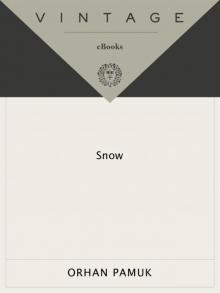 Snow
Snow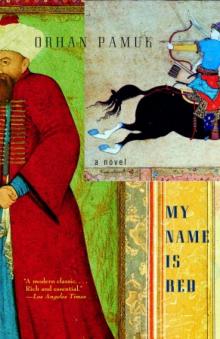 My Name is Red
My Name is Red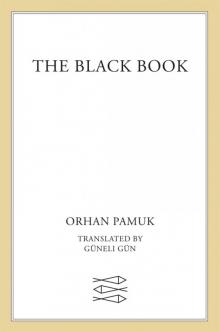 The Black Book
The Black Book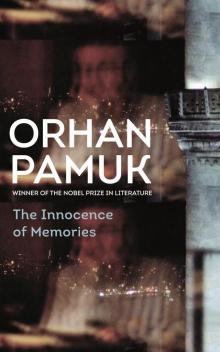 The Innocence of Memories
The Innocence of Memories The White Castle
The White Castle Other Colors
Other Colors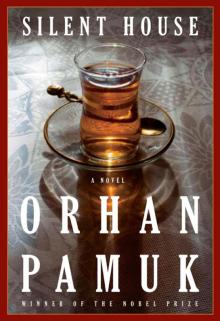 Silent House
Silent House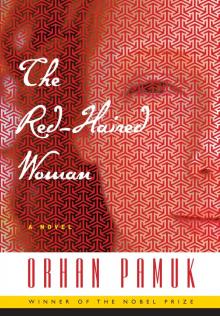 The Red-Haired Woman
The Red-Haired Woman The Museum of Innocence
The Museum of Innocence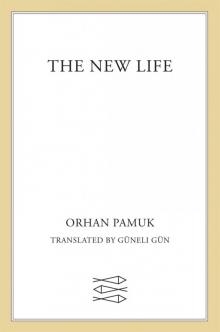 The New Life
The New Life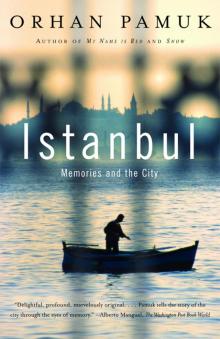 Istanbul
Istanbul